When moving house, one of the biggest challenges you face is moving your bulky furniture and household appliances.
Of course, you want to take all these items with you, but they are notoriously heavy and difficult to move.
Many people opt for a removal company when it comes to moving. Doing so means you don’t need to face the risk of causing damage to yourself or your appliances.
However, removal experts are not the answer for everybody! And moving these heavy household items yourself is possible if you know how.
If you’re wondering how to move a washing machine yourself, you’re in the right place! We take you through the best way of moving this appliance step-by-step so that the removal process is as smooth as possible.
Read on for our easy-to-follow guide and some top tips to help keep you and your washing machine safe.
Preparing to Move a Washing Machine

While it is doable, moving a washing machine yourself will be tricky. These large appliances weigh a considerable amount, so you can’t take the removal process lightly.
One mistake could cause you to damage the machine or injure yourself accidentally.
Therefore, it is vital that you follow the below instructions precisely. Each step is critical in assuring you move your washing machine without pain or damage.
To prepare yourself for the moving process, make sure you have the following equipment to hand:
- A bucket
- An old towel
- Washing machine cleaner
- Slip-joint pliers
- Transit bolts (front-loaders only)
- Packing tape
- Moving blankets
- A dolly
- Rope or bungee cords
How to Move a Washing Machine
1. Empty the washing machine and clean inside
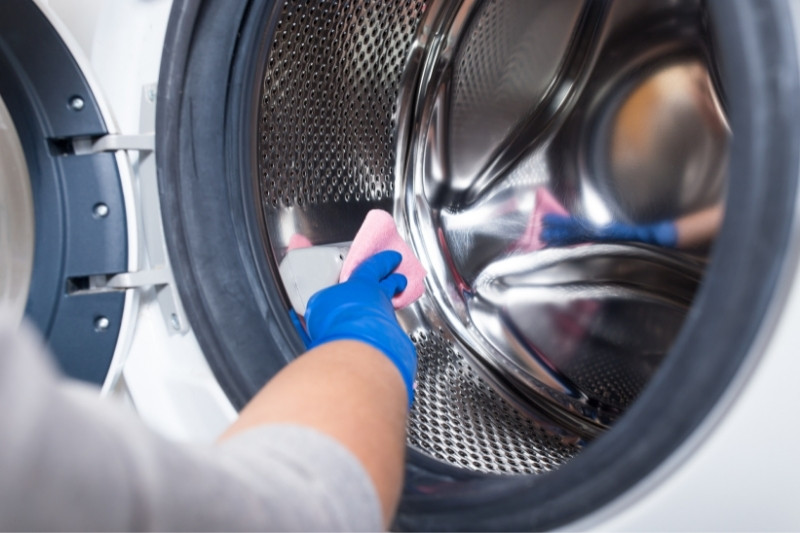
Before you move your appliance, it’s a good idea to clean your washing machine inside and out.
Make sure there are no stray items of clothing in the drum before you start. You can then clean the drum by running an empty cycle on your machine using white vinegar or a commercial cleaner.
Once the cycle is finished, open the door so the drum can dry out over the next day or so.
You can clean the outside of the machine by wiping it clean using a cloth. This needs to be done at least 24 hours before you try to move the machine, as it needs time to dry.
2. Unplug the machine and turn off the water supply
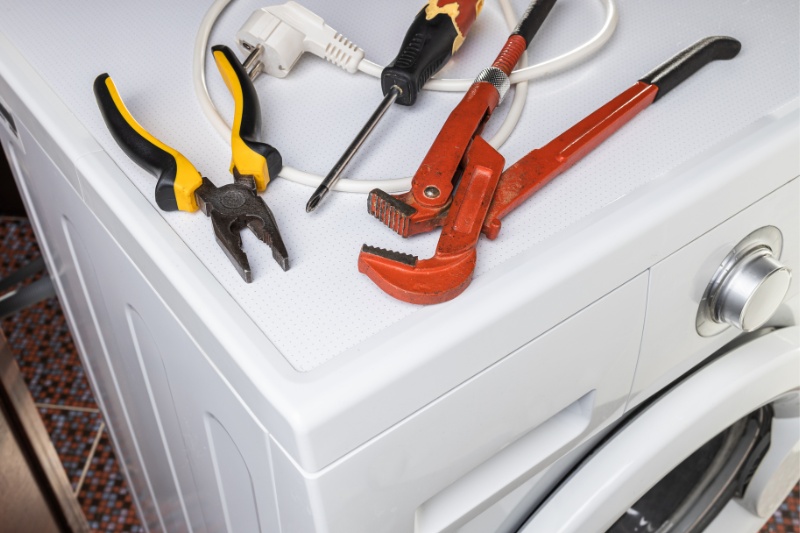
Once the washing machine is clean and dry, it is ready for transportation.
Start by disconnecting your power supply and unplugging your machine. This will prevent you from getting an electric shock during the moving process.
You then need to turn off your machine’s water supply. In most cases, you can do this by turning the water supply valves clockwise.
These valves are found at the back of your washer, so you will need to pull it forward slightly to reach them.
Take care not to pull anything loose while pulling out the machine—you should only pull the machine out as much as is needed to reach the valves.
3. Unfasten the water supply and drain hoses
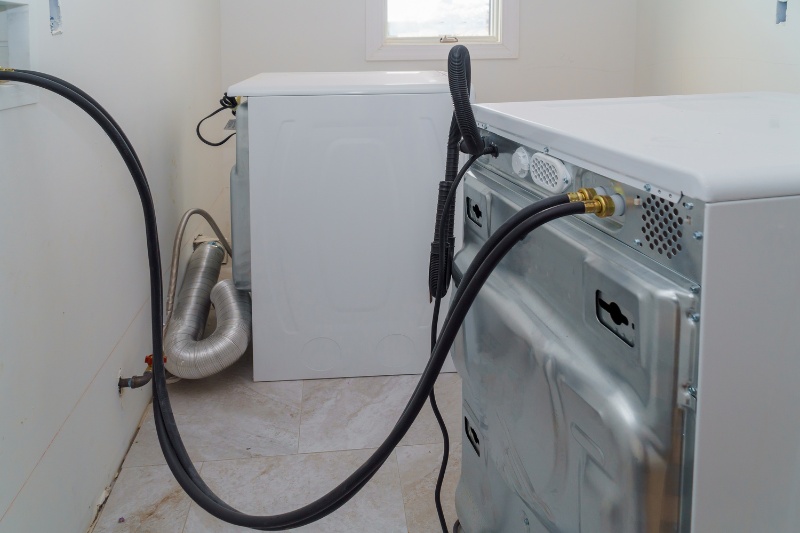
Next, you need to unfasten the water supply hose. Use your slip-joint pliers to detach the hose from the water valve behind the washing machine, then disconnect it from the machine itself.
The drain hose then needs to be detached from the wastewater canal. However, you need to leave this one attached to the machine.
To ensure the drain hose doesn’t get in the way when transporting the machine, tape it in an upright position on the back.
When detaching the hoses, you will likely find that there is still some residual water inside that hasn’t drained away.
To prevent this from spilling onto the floor, place a bucket underneath each hose when unfastening it to catch the excess water. You can also place an old towel on the floor for any accidental spillages.
4. Secure the machine for transit

When moving a washing machine, one of the most important steps is securing it, so it isn’t damaged during transit.
This includes fixing the drum and electrical cords in place, as well as protecting the appliance from possible scratches and dents.
If you have a front-loading washing machine, you will need to insert transit bolts into the back of the machine to secure the drum.
Remove these before using your appliance again, as leaving them in will damage your washer. If you have a top loader, your job is easier; simply wedge a piece of cardboard between the case and the drum.
Next, you need to secure the electrical cord to the back of the washing machine using tape and then wrap the whole thing in moving blankets.
These blankets will also need to be secured by tape. You can skip the moving blankets if desired, but it will leave your washing machine susceptible to scratches and dents while you’re moving it.
5. Move the machine using a dolly
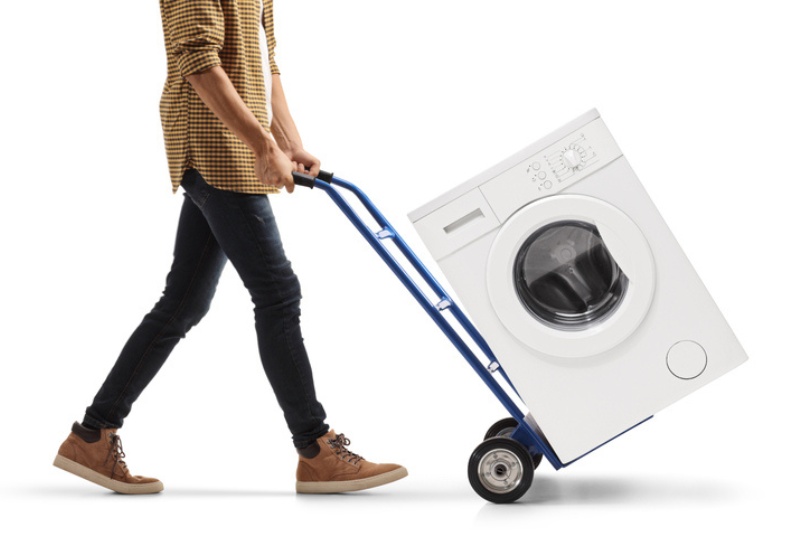
After your washing machine is fully secured, it is ready to be transported. To do this, you will need to use a dolly.
There are two types to choose from: a shoulder dolly and an appliance dolly. Shoulder dollies are the better option if your washing machine is upstairs; otherwise, we recommend using an appliance dolly.
Carefully position your desired dolly under the machine by tilting it backwards and slipping it underneath.
You then need to secure the washing machine to the dolly using rope or bungee cords (appliance dolly) or keep the machine in place using your hands (shoulder dolly).
Slowly move the washing machine out to your vehicle, watching out for trip hazards along the way.
6. Load the washing machine into the vehicle and secure it
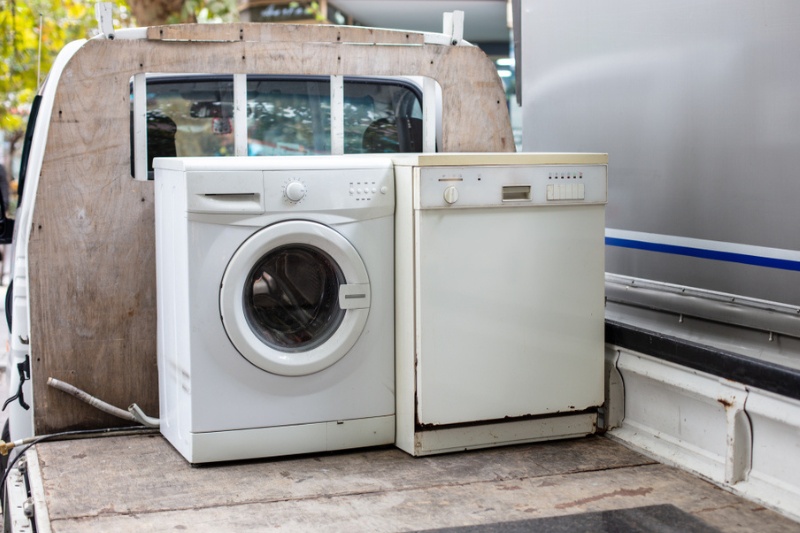
The final step for moving your washing machine is to load it into your vehicle and secure it for transit.
Washing machines must be transported upright to avoid damage, so you will need to hire a van rather than try to fit the appliance in your car.
Most vans come with a ramp that you can use to lift the dolly into the back. If not, you will need to lift the dolly into the van with the help of a friend.
Once inside, unload the washing machine as close to the front of the van as possible and secure it in place with rope or bungee cords. This will stop your machine from moving around during transit.
Top Tips for Moving Your Washing Machine
Moving a washing machine without the help of a professional will always be challenging. Follow the above instructions carefully and check out some of our top tips to make the process go as smoothly as possible.
1. Check your machine’s instruction manual

Before moving your washing machine, make sure you check the instruction manual. Many manufacturers include recommendations for transporting your specific model of machine.
Most user manuals can be found online by searching for the brand and model of your appliance.
2. Measure staircases and doorways
You don’t want to be halfway through moving your washing machine only to realise that it doesn’t fit through a certain door or stairway.
Therefore, you must measure all stairways, hallways, and doorways that the washer must go through before starting the moving process.
Sometimes, you may have to plan a different route out of the house.
3. Enlist the help of friends
As we’ve already covered, washing machines can be incredibly heavy. Moving one by yourself is not an option, so you will need to enlist the help of friends and family to carry out the above steps.
If you don’t have any friends or family available to help you move the appliance, don’t try to move it yourself! This is very dangerous, and it is always better to hire a professional to be safe.
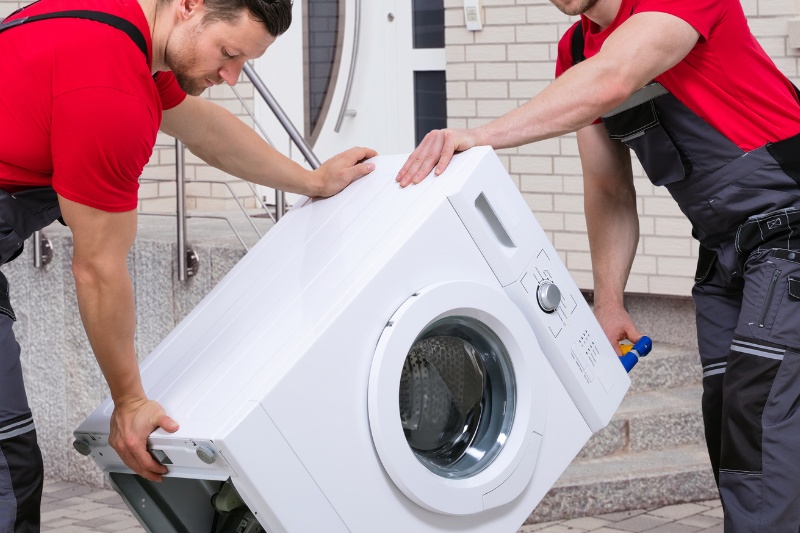
4. Wear gloves and reinforced shoes
When moving a washing machine, it is a good idea to wear reinforced shoes and gloves with a good grip.
These will help you keep your hold on the machine while handling it and protect your toes in case something goes wrong, and the washer is dropped.
5. Store loose parts in the drum
It can be easy to misplace things when moving, so it is a good idea to store any of your washing machine’s loose parts (such as the supply hose) somewhere safe.
We suggest wrapping these parts in an old towel or blanket and storing them in the washer drum, so they don’t go missing!

Hannah has a passion for cleaning. She worked her way around Australia by cleaning hostels in exchange for free accommodation and used her cleaning skills to bag a job as a chalet host for a luxury ski company in France.






